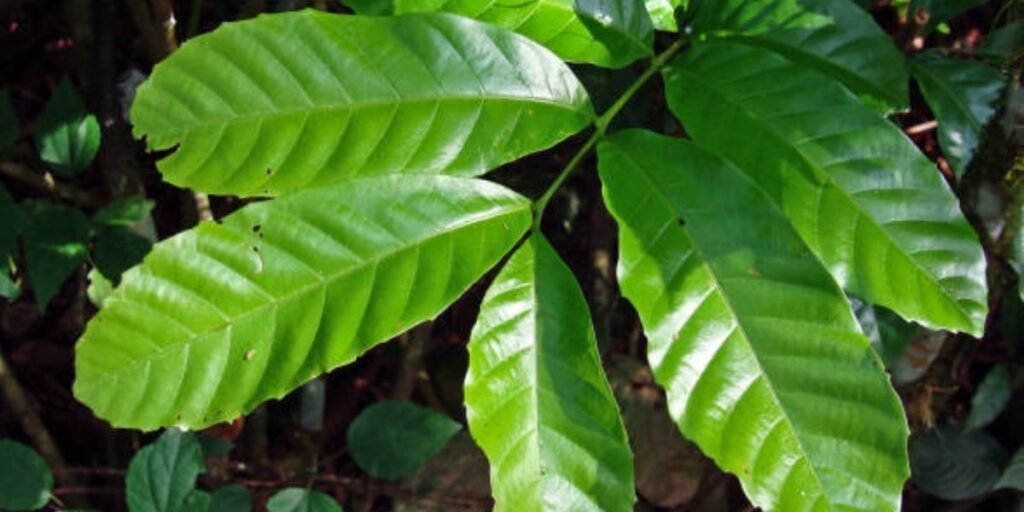The mitragyna speciosa tree can grow up to 25 meters tall and features large, dark green leaves that can reach lengths of up to 20 centimeters. It is native to Southeast Asia, the Philippines, and New Guinea but grown elsewhere.
In Thailand, the Mitragyna speciosa tree and leaf preparations are called kratom. Traditionally, fresh or dried kratom leaves are chewed or made into tea; they are seldom smoked.
The low dose of kratom gives it a stimulating effect, and this is taken during long hours of work. At high dosages, however, it can have sedative-narcotic effects. It is also used in traditional medicine and as an opium substitute.
Some of the phytochemicals include 40 structurally related alkaloids, flavonoids, terpenoid saponins, polyphenols, and different glycosides among others. The main psychoactive components in the leaves are mitragynine and 7-hydroxymitragynine, both found only in Mitragyna speciosa.
What is Mitragynine?
Mitragynine is a chemical compound found in the leaves of the Mitragyna speciosa tree known as kratom. This native to Southeast Asia is mainly grown in Thailand, Indonesia, and Malaysia. Asians have used this for centuries to boost energy, improve focus, and relieve muscle pain.
This alkaloid is in the percentage of 60% of total alkaloid compounds of kratom which makes it the most dominant. However, the amount of mitragynine can vary based on the strain and environmental factors.
This is due to Mitragynine having the ability to bind with opioid receptors in one’s brain leading to several effects that many people who use the substance report to feel including exhilaration, energy boosts, and pain-killing influence. This component is also responsible for sedative and stimulating effects.
However, it is very different from traditional opioids and does not carry the same level of addiction risk that’s why it’s safe to use.
Chemistry Of Mitragyna Speciosa
Molecular structure: Mitragynine
Among the alkaloids present in the leaves, mitragynine ranks highest in terms of its content. It was first isolated as a crystalline substance in 1921 and the nature of the chemical combination of its constituent elements was not determined until 1964.
Mitragynine hardly dissolves in water but dissolves well in ordinary organic solvents such as acetone, acetic acid, alcohols, chloroform, and Diethyl ether to form fluorescent solutions. Mitragynine distils at 230–240 °C at 5 mmHg. It forms white, amorphous crystals that melt at 102–106 °C. The melting point of mitragynine hydrochloric acid salt is 243°C; the picrate melts at 223–224 °C and the acetate at 142 °C.
- Molecular formula: C23H30N2O4
- Molecular weight: 398.50 g/mol
Molecular structure: 7-hydroxymitragynine
7-Hydroxymitragynine was found in samples of kratom leaves in 1993 and its levels are greatly inferior to the amounts of mitragynine.
The chemical total syntheses reported for several kratom alkaloids are too complex to be used for the economic production of any of these compounds. However, mitragynine can serve as a chemical precursor to the more potent 7-hydroxymitragynine.
- Molecular formula: C23H30N2O5
- Molecular weight: 414.50 g/mol
Mitragyna Speciosa Uses

Kratom can be consumed by use of raw or dried leaves chewing them or soaking them in water to make tea. When making tea, lemon juice is often added to facilitate the extraction of plant alkaloids; before drinking, sugar or honey may be added to mask the bitter taste of the brew. These dried leaves can even be smoked when required.
For strength and merriment, common ‘kratom eaters’ take one to three fresh leaves at any one time. The veins are usually availed separately from the leaves or eaten with the leaves and sometimes salt is added to prevent constipation. Only the masticated material is swallowed. Consumption is followed by drinking warm water or coffee, tea, or palm sugar syrup.
Regular and addicted users chew 3 to 10 times a day. When kratom is not available, the leaves of Mitragyna javanica (another named Mitragyna parvifolia) are used as a substitute.
In southern Thailand, in the last few years homemade ice-cold cocktail drinks ‘4×100’ have been circulated among the young Muslim population for they contain alcohol substitutes.
Medical Use Of Mitragyna Speciosa
Though six Asian and four African Mitragyna species are reported to be used in traditional medicine, the sedative, narcotic, and psychoactive effects are unique for Mitragyna speciosa only. In Southeast Asia, kratom is used as an antidiarrheal, a cough suppressant, an antidiabetic, an intestinal deworming agent, and wound poultice as well as to wean addicts off heroin.
In other continents, there are anecdotal reports of kratom preparations being used to self-treat Chronic pain and opioid withdrawal syndrome and as a replacement for opioid analgesics.
There is, however, no approved use of kratom or its alkaloids in modern medicine. It has been suggested that the therapeutic potential of kratom or its purified ingredients for the treatment of pain, depression, and drug withdrawal symptoms should be explored.
Benefits of Mitragynine
Its potential benefits for the human body and mind make it a key reason for people choosing kratom over pharmaceutical pain relievers.
Below are some key benefits of mitragynine based on consumer reviews and preliminary research:
1. Pain Relief
Pain relief is one of the top benefits of mitragynine. It can interact with opioid receptors making it helpful for people dealing with chronic pain conditions such as arthritis, fibromyalgia, and migraines. Research has shown that this component has an analgesic effect which is very useful for people seeking natural pain relief.
Related:
10 Best Kratom Products For Pain Relief
2. Mood Enhancement
Another great benefit of consuming this herb is its potential to improve mode and reduce symptoms of anxiety. It can enhance mood by triggering the release of endorphins and serotonin. Kratom consumption allows users to feel a sense of calm, well-being, and optimism which is primarily due to mitragynine.
3. Increased Energy and Focus
Mitragynine also acts as a stimulant which helps in energy boost and focus. People who are looking for natural alternatives to coffee or other caffeine drinks often opt for kratom. Farmers and laborers in Southeast Asia are using this herb to combat fatigue and increase productivity. They usually chewed the leaves directly torn from the tree.
4. Reduced Dependency Risk
As compared to traditional opioids which are synthetic based this component has a lower risk of dependency which makes it a good option for those seeking natural relief without the addictive potential associated with pharmaceutical painkillers. However, some users consume it in high doses which can lead to dependency over time. The amount of dosage consumed is highly important in kratom intake.
Effects of Mitragynine
The effects of mitragynine are dose-dependent which means you can experience different effects based on the amount consumed. Different dose levels affect the body from different angles.
1. Low Doses (1-5 grams):
At low doses, it provides stimulating effects which include alertness, energy, and focus. However, these effects will last only a few hours. Low dose is consumed as a natural alternative to caffeine as it gives alertness and energy boost without the jittery side effect
2. Moderate Doses (5-10 grams):
If used in an adequate amount, it creates a balance between stimulation and relaxation. Some people also feel a sense of calm with a moderate level of pain relief. People who are looking to alleviate pain or reduce stress while remaining functional throughout the day can use this in moderate amounts.
3. High Dose (10+ grams):
If consumed in higher amounts it can provide sedative effects resulting in deep relaxation and sometimes drowsiness. High dose intake is risky and can be fatal. Several side effects might appear such as nausea, vomiting, diarrhea, and other respiratory issues.
Only people dealing with insomnia can have high doses but under supervision. If you have any underlying health condition do consult with your healthcare provider before mitragynine use.
Safety and Regulation
Despite its widespread use, Mitragyna speciosa remains controversial in many parts of the world. The plant’s effects and potential risks have prompted regulatory scrutiny, with some countries banning its use entirely. In other regions, such as the United States and parts of Europe, kratom is sold legally but often with warnings and restrictions.
Potential Risks:
- Dependency and Withdrawal: Regular use of high doses can lead to dependency, and some users report withdrawal symptoms upon cessation.
- Side Effects: Common side effects include nausea, dizziness, constipation, and dry mouth. In rare cases, more severe reactions may occur, especially when combined with other substances.
Final Thoughts
Mitragyna speciosa is a fascinating and complex plant with a rich history and a wide range of applications. While its potential benefits have captivated users and researchers alike, it is crucial to approach its use with caution and informed decision-making.
Understanding the plant’s properties, effects, and limitations can help individuals make choices that align with their needs and values.
Whether you are exploring Mitragyna speciosa as a botanical curiosity, a potential wellness aid, or a subject of academic interest, its story serves as a reminder of the intricate relationships between humans and the natural world.
By respecting the plant and the cultures from which it originates, we can continue to learn from and responsibly utilize its remarkable properties.
Discover the best quality mitragynine tablets at Occurs Naturally, where you can enjoy a concentrated dose of this powerful alkaloid.
ARTICLE WRITTEN BY: AMAD REHAN

